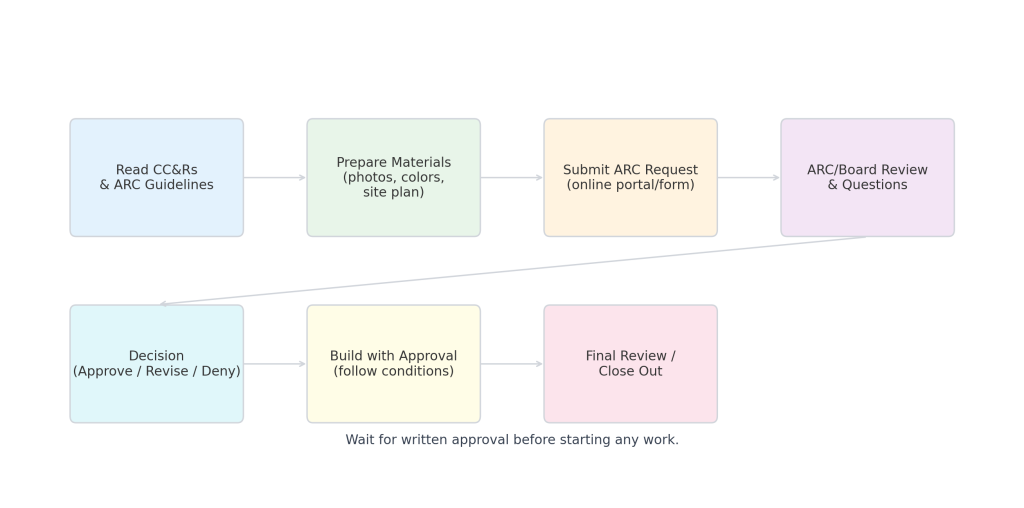Last updated: August 16, 2025
What is an HOA? A homeowners association is a resident-governed organization that sets community rules, maintains common areas, and collects dues to fund services and amenities. In this guide, you’ll learn how HOAs work, what CC&Rs mean for everyday life, what dues cover, and simple steps to avoid fines and enjoy your community.
TL;DR: An HOA manages rules and shared spaces so the neighborhood stays attractive and well-maintained. Read your CC&Rs, know what dues fund, submit ARC requests before exterior changes, and use tools like RunHOA’s document portal and online payments to make life easier.
Table of Contents
- How an HOA Works
- Pros and Cons of HOA Living
- Common Scenarios for New Owners
- How to Work With Your HOA
- Tools That Make HOA Life Easier (RunHOA)
- FAQs
- Free Checklist for New HOA Homeowners

How an HOA Works (Boards, CC&Rs, and Management)
An HOA is a private, nonprofit (or similar) entity created when a community is developed. After the developer turns control over, a resident-elected Board of Directors runs the association. Many communities also hire a management company for day-to-day operations.
CC&Rs: The Rules You Agree To
CC&Rs (Covenants, Conditions & Restrictions) set the standards for property appearance and use—things like exterior paint colors, landscaping, parking, pets, and short-term rentals.
- Review the sections on architectural changes, vehicles, and violations first.
- Keep a digital copy in your RunHOA document portal for quick search.
Board of Directors vs. Management Company
The Board makes policy and budget decisions; a management company executes them (billing, vendor coordination, homeowner communications). Homeowners can attend meetings, vote in elections, and run for the board.
Dues, Special Assessments, and What They Fund
Dues (monthly/quarterly/annual) cover common-area maintenance, amenities, insurance, management, and reserves. Special assessments fund major unexpected projects.

Tip: Ask for the latest budget and reserve study before buying or joining the board. Underfunded reserves can mean future special assessments.
Pros and Cons of HOA Living
Benefits: Property Values, Amenities, Standards
- Well-maintained common areas and amenities.
- Consistent standards help protect property values.
- Dispute handling and rule enforcement keep things orderly.
Drawbacks: Restrictions, Costs, Miscommunication
- Rules can limit exterior changes or parking options.
- Dues/special assessments add ongoing costs.
- Poor communication can create frustration—fixable with better tools.
Common Scenarios for New Owners
Getting Architectural Changes Approved
Most exterior work requires an ARC (Architectural Review Committee) approval. Submit materials, paint chips, drawings, and timeline—and wait for written approval.

Parking, Pets, and Short-Term Rentals
Check the rules for driveway/garage parking, RVs, visitor passes, pet limits, and STRs. Each has different fines or enforcement procedures, so confirm before you act.
Handling Notices and Fines (and Appeals)
Most HOAs give notice and time to cure. If you disagree, respond in writing, cite your documents, request a hearing, and bring photos or receipts.
How to Work With Your HOA (Not Against It)
- Read these 5 pages first: CC&Rs on use rules; Bylaws (board powers); ARC guidelines; Fee schedule; Violations policy.
- Communicate early: Ask questions before you buy materials or start work.
- Show up: Attend meetings, vote, and join committees to shape outcomes.
Pro move: Keep all HOA docs and approvals in one place. With RunHOA Documents and ARC Requests, you can find what you need in seconds.
Tools That Make HOA Life Easier (RunHOA)
- Pay dues online and see current balances.
- Submit ARC requests with photos and track decisions.
- View violations and status for transparent, fair enforcement.
- Access documents, meeting minutes, and policies 24/7.
- Get announcements, email blasts, and event reminders.
- See budgets and reports for financial transparency.
FAQs
What is an HOA?
A community association that creates and enforces rules, maintains shared spaces, and collects dues to fund services and amenities.
What do HOA dues pay for?
Landscaping, amenities, insurance, reserves, management, and repairs—check your budget and reserve study.
Can an HOA fine me?
If authorized by your documents, yes—typically after notice and an opportunity to cure or appeal.
How do I get exterior changes approved?
Submit an ARC request with materials/colors/drawings and wait for written approval.
What if I disagree with a violation?
Respond in writing, request the specific policy cited, ask for a hearing, and provide photos or documents.
Free Checklist for New HOA Homeowners
- Save digital copies of CC&Rs, Bylaws, ARC rules, fee schedule, violations policy.
- Confirm dues amount, due dates, late fees, and how to pay online.
- Review the latest budget and reserve study for funding levels.
- Map key contacts: board, management, vendors (landscaping, pool, security).
- Note ARC lead times; plan projects around meeting schedules.
- Set up alerts in RunHOA Communications for announcements and meetings.
Useful resources: HUD Fair Housing & Equal Opportunity • Community Associations Institute (CAI)
About RunHOA — Modern HOA management software for communications, payments, violations, ARC requests, documents, and accounting. Try the demo.
